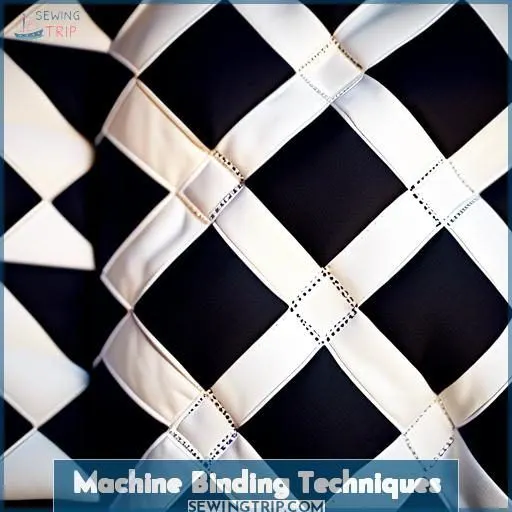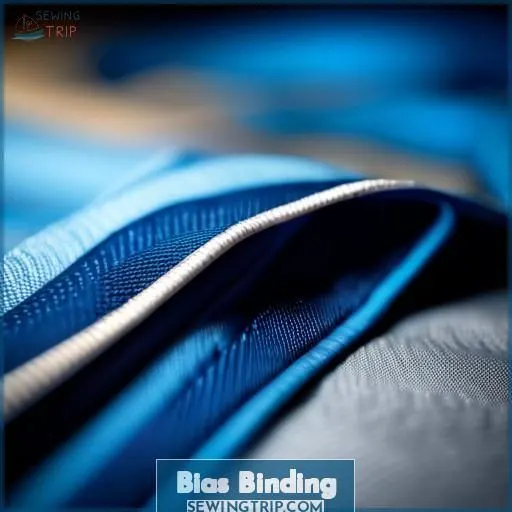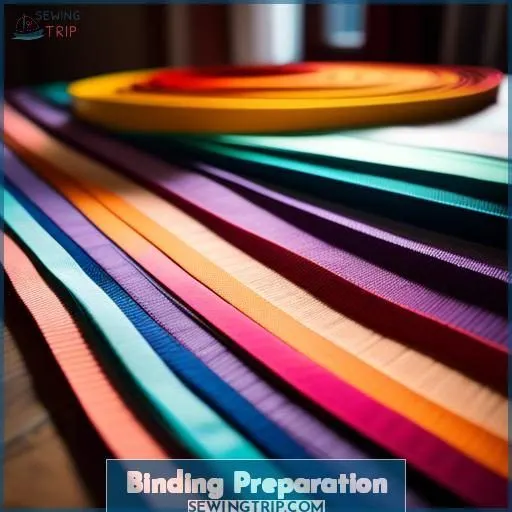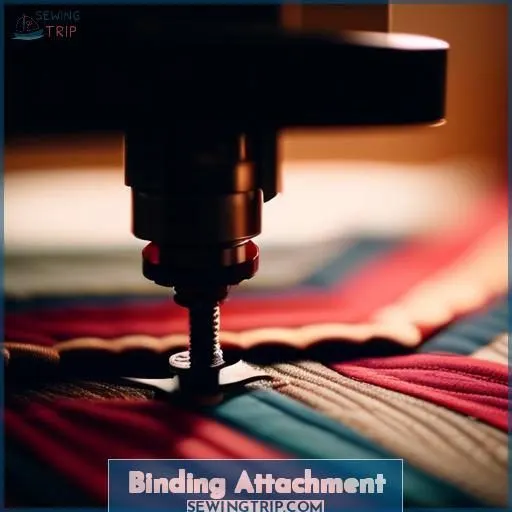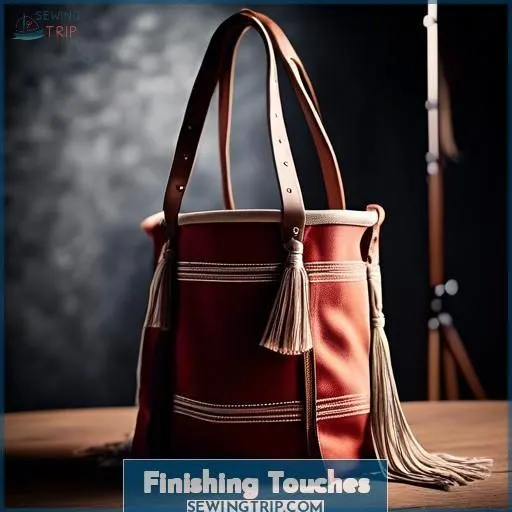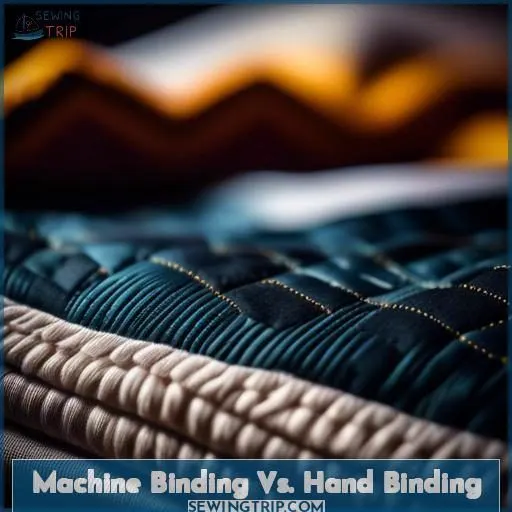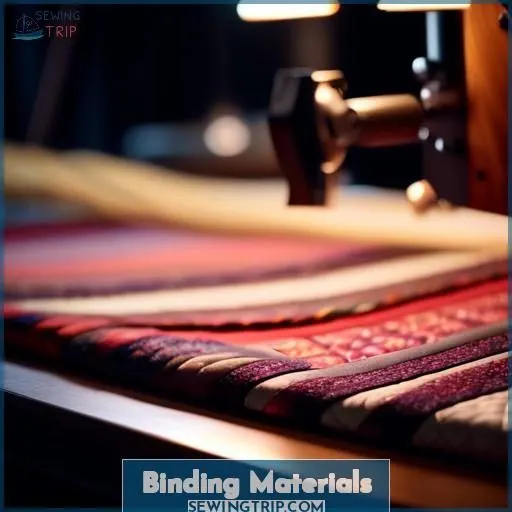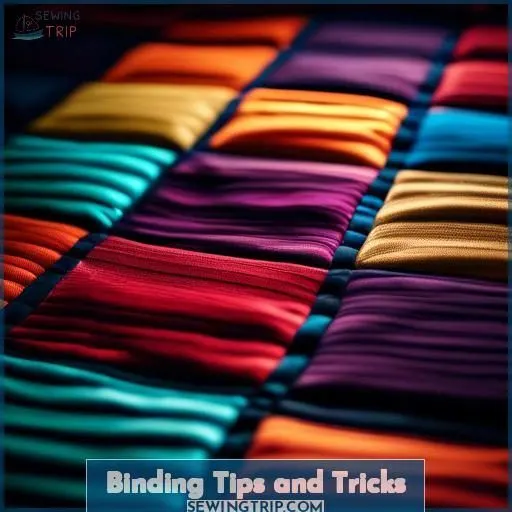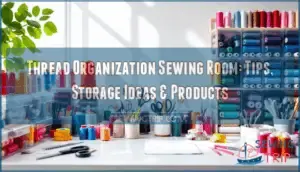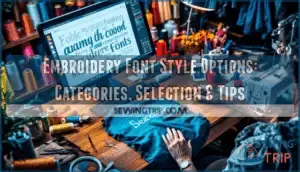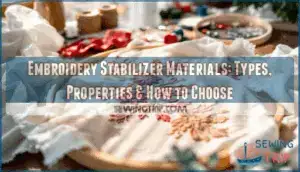This site is supported by our readers. We may earn a commission, at no cost to you, if you purchase through links.
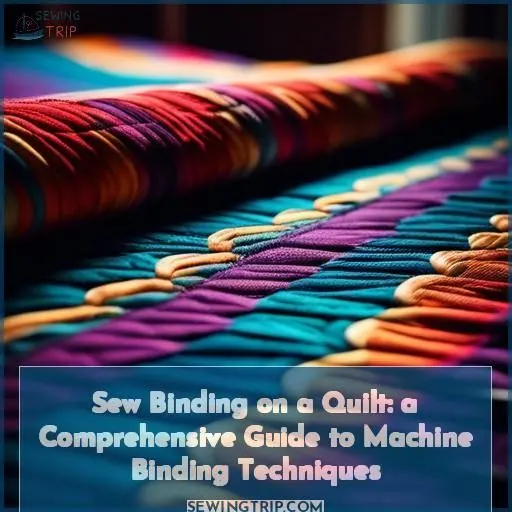 To sew binding onto your quilt, start by cutting 2.5-inch binding strips. Join the strips and fold the binding in half. Sew it to the back of the quilt using a quarter-inch seam allowance, then flip it over and stitch it to the front.
To sew binding onto your quilt, start by cutting 2.5-inch binding strips. Join the strips and fold the binding in half. Sew it to the back of the quilt using a quarter-inch seam allowance, then flip it over and stitch it to the front.
Be sure to use thread that complements your quilting thread and adjust your stitch length to match the quilting stitches. Hand stitching or machine stitching can be used to secure the binding.
For a polished finish, press the seams open and consider using a bias cut binding. To delve further into the art of quilt binding, continue reading for an extensive guide.
Table Of Contents
Key Takeaways
- Sew binding to the back of the quilt first, then flip it over and sew it to the front.
- Use thread that complements your quilting thread and adjust your stitch length to match the quilting stitches.
- Hand stitching or machine stitching can be used to secure the binding.
- Press the seams open for a smooth finish and consider using bias-cut binding for a polished look.
Machine Binding Techniques
Setting up your sewing machine properly is key for smooth machine binding. Follow the step-by-step tutorial to master the art of machine binding your quilt with precision.
Setting Up Your Sewing Machine
Preparing your sewing machine for machine binding a quilt is an essential step in the process. Here’s how to do it:
- Thread selection: Select a thread that harmonizes with the hue of your quilting thread.
- Needle size: Utilize a needle suited for quilting, such as a robust needle.
- Presser foot type: Replace the presser foot with a walking foot if you have one. This will aid in keeping the fabric moving in concert on the upper and lower sides, minimizing distortions, ridges, and gaps.
- Stitch length: Modify the stitch length to align with the stitch length in the quilting, typically around 3.5mm. You may need to adjust the stitch length based on the thickness of the binding and quilt top.
Making the Quilt Binding
To make the quilt binding, you’ll first need to calculate the fabric requirements. You can use a binding calculator to determine the amount of fabric needed based on the quilt’s width and length, as well as the width of the binding strips you wish to use. Once you have the fabric, you’ll need to prepare it by cutting four 2.5-inch strips from the binding fabric. These strips should be cut straight or on a 45-degree angle for bias binding, depending on the desired look and the quilt’s shape.
Next, join the binding strips by sewing them together along the fold line, pressing the seams open to reduce bulk. If you’re using bias binding, you’ll need to sew the ends together and press them open before folding the binding in half.
When attaching the binding to the quilt, it’s important to press the seams open to create a smooth finish. You can use a walking foot on your sewing machine to help control the fabric and maintain even stitching. Machine binding is generally faster and more durable than hand binding, making it a popular choice for many quilters.
Remember to select the appropriate binding fabric and thread based on the quilt’s weight and composition, and consider the thread type (cotton or polyester) for the best results.
Machine Binding Tutorial in Steps
Machine binding a quilt is a popular method for achieving a professional-looking finish. Here are the steps to follow when machine binding a quilt:
- Binding Placement: Sew binding to the back of the quilt first, then turn it over and sew it to the front.
- Color Selection: Use thread that complements your quilting thread and makes sure the binding stitches blend seamlessly with the quilt.
- Fabric Types: Select fabric types that match your quilt, such as quilting cotton for cotton quilts.
- Stitch Length: Adjust stitch length to match the quilting stitch length for a consistent look.
- Machine Maintenance: Make sure your machine is in good working order before starting the binding process.
- Quarter-Inch Seam: Use a quarter-inch seam allowance when binding.
- Binding Stitches: Choose a stitch that matches your quilt, such as a decorative stitch for a unique touch.
- Bobbin Thread: Check that the bobbin thread matches the top thread to get even stitching.
- Edge Stitching: Sew the binding to the quilt’s edge with a quarter-inch seam allowance.
- Continuous Stitch: Join the binding strips to create a continuous strip, then press it in half.
- Binding Attachment: Pin the binding to the quilt’s edge with raw edges lined up, then sew it down with a quarter-inch seam allowance.
- Mitering Corners: Fold the binding diagonally to create a mitered corner, then continue sewing and overlap the binding at the starting point.
- Hand Stitching or Machine Stitching the Binding Down: Hand stitch the binding to the back of the quilt using a blind hem stitch, or sew it down by machine.
Machine Stitching on the Front
After you’ve prepped your quilt, it’s showtime for the front! With your walking foot or dual feed system engaged, needle control is key. Aim for a decorative stitch or straight stitching that hugs those straight edges. Adjust your stitch length, keep an eye on the bobbin thread, and navigate those mitered corners like a pro.
It’s not just sewing; it’s quilting with flair!
Hand Stitching or Machine Stitching the Binding Down
Now that you’ve mastered machine stitching on the front of your quilt, it’s time to tackle the back. You can choose between hand sewing or machine sewing the binding down. Hand sewing offers a more traditional look, while machine sewing is quicker and more durable.
For a decorative touch, consider using a blind stitch or a decorative stitch. If you’re feeling adventurous, you can even try hand binding with a hand sewing needle and quilter’s knot.
Bias Binding
Cutting bias strips for your quilt binding adds a touch of elegance and extra durability. Sewing the bias binding to your quilt takes a bit more effort, but the results are worth it.
Cutting Bias Strips
To cut bias strips for your quilt binding, you’ll need to cut your fabric at a 45-degree angle, lining up the 45-degree line on your ruler with one edge of your fabric. This allows you to create a diagonal fold, which is essential for binding curves or adding a decorative touch to your quilt. Bias binding is more durable and can provide a smoother finish than straight-cut binding.
When cutting bias strips, it’s important to think about the width of your strips. A common width for quilt binding is 2.5 inches, which is folded over to create a 1.25-inch finished width. You can also choose to use a wider strip, such as 3.5 inches, and fold it over to create a 1.75-inch finished width.
Remember to match the weight and composition of your binding fabric with the quilt fabric, and use the same fabric for the entire binding or create a patchwork effect with contrasting fabrics. When cutting bias strips, make sure that the bottom fold is straight, as if you were cutting strips from the length or width of the fabric.
Bias binding can be more enduring and give a smoother finish to your quilt, making it a great choice for curves and decorative elements.
Joining Bias Strips
To join bias strips for binding, follow these steps:
- Position and pin bias strips perpendicular to each other with right sides together and raw edges aligned.
- Draw a diagonal line on top bias strip from top left to bottom right.
- Sew on marked line to make a diagonal seam.
- Trim seam allowance to 1/4 and press seam allowance open.
- Fold and press edges toward center of bias strip.
- Fold pressed strip in half; press to make one continuous folded bias strip.
Sewing Bias Binding to the Quilt
Sewing bias binding to a quilt offers several advantages over straight-cut binding, especially when dealing with curved edges. Bias binding has more stretch and durability due to the diagonal grain of the fabric, making it more suitable for scalloped or rounded borders. Here’s how to sew it to your quilt:
- Cutting Bias Strips: Cut 2.5-inch strips at a 45-degree angle to create bias binding.
- Joining Bias Strips: Sew the ends together, press open, and fold in half.
- Mitering Corners: Fold the binding diagonally and then down to miter the corners.
- Finishing: Sew the binding to the quilt with a quarter-inch seam allowance, stopping 1/4 inch from corners.
To create a more decorative finish, you can use different stitching techniques like blind stitches, hidden stitches, or funky folds. Bias binding is also more durable and can handle curves better than straight-cut binding.
Bias Binding Vs. Straight-Cut Binding
After mastering sewing bias binding to your quilt, let’s explore the debate: bias binding vs. straight-cut binding. Here’s the lowdown:
- Bias binding provides exceptional durability and stretch, ideal for those curved edges.
- Straight-cut binding, while simpler to create, lacks the flexibility but excels in aesthetics for straight edges.
- Bias binding requires a bit more fabric but enhances quilt designs with its versatility.
- Ultimately, selecting between them relies on your project’s requirements and your desire for quilting excellence.
Binding Preparation
To get your quilt ready for binding, start by pressing the seams open on your binding strips. Then, fold each strip in half lengthwise and pin the binding to the raw edge of your quilt, making sure to miter the corners for a professional finish.
Pressing Seams Open
When preparing your quilt for binding, pressing seams open is a vital step. This technique involves laying the right side of the quilt block against your ironing board and using the tip of your iron to gently separate the two sides of the seam allowance. Press straight down, then lift the iron slightly before moving it forward to separate the next part of the seam allowance. Continue until you have pressed the entire seam.
If desired, turn the block over and press again from the right side. Pressing seams open can make the quilt blocks turn out the desired size more consistently and give a seamless look.
However, if you plan to quilt using a stitch in the ditch approach, those flat seams mean that you don’t have a ditch to stitch in, and stitching between the two patches can mean you’re not quilting through your quilt top at all.
Folding Strips in Half
To fold your binding strips in half, follow these steps:
- Lay out your binding strips, ensuring they’re straight and aligned.
- Fold the strip in half lengthwise, with the wrong sides together and the cut edges aligned.
- Press the fold firmly to create a crisp crease.
- Repeat this process for all binding strips.
Pinning Binding to Quilt’s Edge
To pin binding to a quilt’s edge, follow these steps:
- Fold the binding strip to the right, at a 90-degree angle. This makes sure that the binding is properly aligned with the quilt’s edge.
- Finger-press the fold to flatten it in place. This helps keep the binding’s shape and prevents it from moving as you sew.
- Pin the binding to the quilt’s edge. Use pins to hold the binding in place, aligning the raw edges of the binding with the raw edge of the quilt.
- Miter the corners. Fold the binding up so that its raw edge is parallel with the quilt’s next side, creating a 45-degree fold in the binding.
Remember to use precise methods and alignment strategies when pinning the binding to the quilt’s edge. This will help keep the fabric taut and make sure the mitering is consistent throughout the process.
Mitering Corners
Mitering corners is a crucial step in quilt binding preparation. It entails bending the binding strip at a 45-degree angle to create a smooth join at the corners. This technique enhances the professional look of your quilt and forms the basis for flawless mitered corners. Here are some pointers on mitering corners for your quilt binding:
- Grasp the Technique: To miter a corner, fold the binding strip in half along its length, aligning the raw edges. This results in a quilt that radiates elegance and craftsmanship.
- Practice: Experiment with mitering corners on fabric scraps before commencing your quilt binding. This will familiarize you with the technique and guarantee that your corners are uniform and consistent.
- Utilize the Appropriate Tools: Certain sewing machines feature presser feet with markings that indicate the distance from an approaching edge, which aids in mitering corners.
- Resolving Issues: If you encounter difficulties with your mitered corners, consider employing a straw needle to secure the binding or utilizing Wonder Clips to hold the binding fold in place as you approach the area for stitching.
- Ornamental Mitered Corners: For a more intricate technique, you can create ornamental mitered corners by incorporating contrasting fabrics or adding embellishments to the corners.
Pressing Creases and Trimming
After sewing your binding, it’s time to iron out the kinks—literally. Pressing fabric guarantees your quilt looks crisp, not crumpled. Here’s how to master it:
- Iron for Excellence: Iron binding flat for that professional touch.
- Trimming Excess: Snip away the surplus for sleek edges.
- Angle Precision: Fold and press with precision, making every corner sharp and every crease exact.
Binding Attachment
Ready to attach the binding to your quilt? Start by sewing the binding to the back of the quilt, ensuring a 1/4-inch seam allowance. Then, flip the binding over to the front, pinning it in place and stitching close to the folded edge.
Attaching Binding to the Back of the Quilt
When it comes to attaching binding to the back of a quilt, there are a few key steps to follow. First, you’ll want to decide on your binding placement. This can be done by either attaching the binding to the front of the quilt first or the back. If you’re using a machine to bind the quilt, it’s often recommended to attach the binding to the front first, as it creates a more invisible attachment when finished by machine.
Once you’ve determined the starting point for your binding, you’ll need to consider the seam allowance. A common choice is a 1/4-inch seam allowance, which allows for easy folding and hand stitching to the back of the quilt. However, you may choose to use a wider seam allowance, such as 1/2 inch, for added stability and support.
When mitering the corners, it’s essential to ensure precision for a neat finish. You can use a backstitch to secure the corners, which will help maintain the binding’s shape and prevent it from fraying.
Remember to trim any excess fabric at the overlap, and join binding strips by sewing along the fold line. This will help create a smooth and even binding edge.
Joining Binding Strips
Once you’ve attached the binding to the back of your quilt, it’s time to join the binding strips. This is an essential step in the binding process. Start by trimming any excess binding fabric and pressing the seams open.
Then, pin the binding strips together with right sides facing and sew along the fold line. Remember to press the seam open and lay your quilt flat.
Finally, hand stitch the binding to the back of your quilt using a blind hem stitch.
Flipping Triangle Flaps at Corners
When flipping triangle flaps at corners, follow these steps:
- Fold the binding diagonally to create a triangle.
- Fold the triangle down to align the raw edges with the quilt’s edge.
- Pin the binding to the quilt, making sure the raw edges are aligned.
Handling methods vary between blind stitching and machine stitching options. Choose the one that suits your project and personal preference in the hand stitching vs. machine stitching debate. Make sure fabric matching considerations are taken into account.
Sewing Binding to Quilt With a Quarter-Inch Seam Allowance
To sew binding to your quilt with a quarter-inch seam allowance, start by adjusting your stitch length to match the length of your quilting stitches. Use a walking foot for better fabric control.
Attach the binding to the back of the quilt first, starting halfway down one side and leaving an 8-inch tail. Miter corners by folding the binding diagonally and then down. Join binding strips using a 2.5-inch spacer guide.
Once the binding is attached, flip the quilt over and wrap it to the front. Bring the bobbin thread to the top and stitch 1/8 inch away from the folded edge of the binding. Control where the stitching line finishes on the front by stopping and starting the needle at the point where the miter folds meet.
Trim any loose threads, press the binding flat, and admire your finished quilt!
Finishing Touches
Finish your quilt with a few key steps. Wash the quilt to give it an antiqued look, using a color-catcher sheet to prevent color bleeding, and admire your accomplished work.
Washing Quilt
Once you’ve stitched your binding, it’s time to give your quilt character. Hand washing can gently age it, achieving that coveted antiqued look. If you’re using quilt backing for binding, make sure it’s secure before the plunge. Machine washing? Go easy to protect those edges. Remember, this step is key to preventing color bleeding and truly completing your masterpiece.
Using Color-Catcher Sheets
Using color-catcher sheets when washing your quilt is a sensible addition to your laundry routine. These sheets absorb and trap loose dyes released during the washing cycle, preventing them from staining other clothes in the load.
They’re particularly useful when washing new, vibrant, or dark-colored garments that have a higher chance of bleeding. To use color-catcher sheets, simply add one or two sheets to the washing machine along with your laundry. They’re only good for one wash cycle; after using once, you should throw them away.
If they accidentally end up in the dryer, that’s no big deal. Follow the instructions provided by the manufacturer for best results. You can buy these sheets on Amazon or at local big box stores like Walmart.
Pre-Washing Fabric
Pre-washing fabric is an essential step in quilt making to guarantee the fabric’s quality, colorfastness, and shrinkage control. By pre-washing, you can prevent dye bleeding, eliminate excess starch, and minimize shrinkage, which helps maintain the appearance and structural integrity of your quilt in the long run.
It also softens the fabric, making it easier to work with.
However, certain fabrics, such as precut squares and strips, shouldn’t be pre-washed due to the risk of fraying and distortion.
Always follow the fabric manufacturer’s recommendations for pre-washing to achieve the best results.
Softening and Puckering Quilt
To soften and pucker your quilt, follow these steps:
- Wash your quilt: Use a color-catcher sheet to prevent color bleeding. Pre-wash fabric from chain stores before use.
- Dry your quilt: Avoid high heat, as it can cause shrinkage and damage.
- Iron your quilt: Use a low heat setting and press the quilt from the back to avoid damaging the binding.
Sharing and Admiring Finished Quilt
After pouring your heart and soul into your quilt, it’s time to share your masterpiece with the world. The quilting community is known for its warmth and appreciation, so don’t hesitate to share your experience.
When you reveal your finished product, you’ll likely receive compliments that will make your hard work worth it.
So go ahead, show off your quilt and enjoy the admiration it deserves!
Machine Binding Vs. Hand Binding
In the realm of quilt binding, a choice must be made between machine binding and hand binding. Each technique possesses unique merits and drawbacks, so it’s imperative to meticulously evaluate the demands of the project to determine the most suitable approach.
Comparison of Techniques
After giving your quilt that cozy, puckered finish, it’s time to choose your binding technique. Hand stitching offers a touch of tradition, with double fold binding hugging your quilt’s edges like a warm embrace. Straight-cut binding is the trusty sidekick, while bias binding flexes around curves with ease. Each method stitches its own story into your quilt’s aesthetics.
Advantages and Disadvantages
Regarding quilt binding, you have two primary choices: machine binding and hand binding. Each technique has its merits and drawbacks, guiding you in selecting the most appropriate one for your project. Here are four crucial aspects to ponder:
- Machine swiftness: Machine binding surpasses hand binding in speed, a notable advantage for expansive quilts.
- Thread tension and presser foot force: Machine binding necessitates greater precision in these aspects to attain a tidy finish, whereas hand binding offers greater leeway.
- Needle type: Hand binding generally employs a diminutive needle, potentially more challenging to procure and swap than the needles used in machine binding.
- Quilt dimensions: Machine binding is generally more suitable for large quilts, while hand binding may be preferred for smaller projects or for imparting a more personalized touch.
Choosing the Right Method for Your Project
Choosing the right method for your quilt binding project depends on various factors, including fabric selection, binding attachment, and your personal preference.
Machine binding is faster, more durable, and suitable for thick or thin batting.
Hand binding offers a more traditional look.
Bias binding is stretchier and suitable for scalloped or rounded borders, while straight-cut binding is more common.
Consider the project’s complexity, your skill level, and the desired outcome when deciding between machine and hand binding.
Binding Materials
Regarding quilt binding, the fabric, thread, and needle selection are vital to its success. Choose materials that enhance the quilt top and ensure durability and longevity.
Types of Fabric for Binding
When choosing fabric for binding, consider quilting cotton alternatives for durability and compatibility with your quilt’s fabric. Bias binding has more stretch, making it suitable for scalloped or rounded borders. The thread weight can impact the binding’s appearance and performance. Contrasting fabric placement and patchwork binding designs add visual interest to your quilt.
Thread Selection
Regarding thread selection for binding, there are several crucial aspects to bear in mind. Initially, you’ll want to align the thread’s thickness with your quilt fabric for a unified appearance. Alternatively, you can opt for a contrasting thread to enhance visual appeal.
For resilience and longevity, think about utilizing a premium, versatile thread. Keep in mind, the appropriate thread can significantly impact the final presentation of your quilt.
Choosing the Right Needle
Just as you’ve matched your thread to your quilt’s fabric, needle selection is key to a smooth binding experience. Needle size and type matter; a too-thick gauge can bulldoze through delicate fabric, while the right needle point glides like butter.
Opt for a sharp, slender needle that won’t play tug-of-war with your materials, ensuring your stitches are invisible ninjas of durability.
Other Necessary Tools
To bind a quilt, you’ll need a few essential tools. First, you’ll need a presser foot that matches the width of your binding. This will help guide the binding as you sew it onto the quilt. A walking foot is also useful for controlling thicker or thinner batting.
Next, consider using a 2.5-inch wide binding strip. This width is suitable for most quilts and provides a good balance between coverage and visibility. You can use a quarter-inch seam allowance when sewing the binding to the quilt.
For hand stitching the binding down, you’ll need a needle and thread that match the quilting thread. A blind stitch is a popular choice for this task, as it’s less visible on the front of the quilt.
Quilting cotton is a common choice for binding, as it matches the weight and composition of the quilt fabric. You can also use the same fabric for the entire binding or create a patchwork effect by using contrasting fabrics.
Double fold binding is a popular choice for durability and a smooth finish. To create double fold binding, you’ll need to fold the binding in half lengthwise, wrong sides together, and press it to set the crease.
Other necessary tools for binding include a quilting ruler, a rotary cutter, and a cutting mat. These will help you accurately cut the binding strips and ensure that they’re the correct length for your quilt.
For sewing the binding to the quilt, you’ll need a sewing machine in good working order. A high-quality sewing machine needle is also essential for smooth stitching.
Binding Tips and Tricks
Struggling with perfect mitered corners or hand stitching the binding flawlessly? Don’t fret – we’ve got you supported. In this section, we’ll share expert techniques and handy tips to help you master those tricky binding details and elevate your quilt to new heights.
Common Mistakes and Solutions
Avoid common binding troubles like bulky corners and puckering quilts with these tips:
- Thread Choices: Use a thread that matches your quilting thread for consistent results.
- Machine vs Hand: Consider the thickness of your quilt and choose the appropriate method.
- Binding Strips: Press seams open and fold strips in half to guarantee a smooth finish.
- Binding Attachment: Pin binding to the quilt’s edge with raw edges aligned and miter corners at 45-degree angles.
Techniques for Perfect Mitered Corners
Creating immaculate mitered corners is vital for a refined binding finish. Here are methods to avert common errors:
- Measure carefully: Imprecise measurements can result in asymmetrical miters.
- Flatten seams: This guarantees that binding lays smoothly and prevents wrinkling.
- Fold binding diagonally: Fold binding at a 45-degree angle to create ideal miters.
- Use a ruler: Ensure binding is evenly distributed when sewing to avoid asymmetrical miters.
- Practice on scraps: Rehearse on scraps before binding your quilt to hone your technique.
Tips for Hand Stitching Binding
Hand stitching binding is a traditional method that adds a personal touch to your quilt. Start by choosing a needle with a sharp point and a large eye for easy threading. Adjust thread tension to match the quilt fabric. Use a blind hem stitch for a neat finish.
Remember to stitch slowly and evenly, keeping the needle at a 45-degree angle to the binding edge. Finish by pressing the binding flat and admiring your handcrafted masterpiece.
Creating Custom Binding Patterns
Custom binding ideas can elevate your quilt’s appearance and create a unique visual impact. You can combine fabrics, add embellishments, or experiment with different colors to achieve a personalized look. Here are some tips for creating custom binding patterns:
- Combining fabrics: You can use different fabrics for the binding of your quilt. This can be done by using a contrasting fabric for the binding or by creating a patchwork of different fabric strips. This can add a more scrappy look to your quilt.
- Adding embellishments: Embellishments like crocheted lace or bundled fringe trim can be added to the binding to give it a unique touch. This can be done using any type of trim that works best for your project.
- Color harmonies: You can experiment with color harmonies for the binding. This includes using analogous, triadic, and complementary colors. You can also try using a different value for the binding color than the colors in your quilt.
- Dimensional binding: Folded fabrics can create an exciting binding edge. You can sew prairie points into the seam, which will pop out from the seams when you turn the quilt right side out.
- Thread selection: The type of thread you use to sew the binding in place can also influence the appearance of your quilt. Some people prefer to use polyester thread because it can appear to melt into the fabric, giving a more invisible finish.
Binding for Different Quilt Styles
Binding a traditional quilt requires a different approach than a modern quilt. Consider the quilt’s style and design when selecting the binding technique that will best complement your finished piece.
Traditional Quilt Binding
Traditional quilt binding is a classic method of finishing quilts, often using a double fold binding for added durability. Here are some key steps to follow:
- Fabric Selection: Choose a fabric that complements your quilt, ensuring it matches in weight and composition.
- Attaching Binding: Start at the center of the bottom edge, pinning the binding to the quilt with a 1/4 inch seam allowance. Sew binding down, stopping 1/4 inch from corners and mitering them by folding binding diagonally.
- Finishing Binding: Trim excess fabric at overlap, join binding strips by sewing along the fold line, and press the seam open. Finally, hand stitch binding to the back of the quilt using a blind hem stitch.
Modern Quilt Binding
In the realm of contemporary quilting, binding holds immense significance as a final step. Regarding the choice between hand or machine stitching, it hinges on your preferences and the aesthetic of your modern quilt.
Machine stitching offers a swift and robust option, while hand stitching provides a personalized touch and meticulous control. Ultimately, the decision is yours, as both methods can yield exquisite, tailored patterns for your modern quilt.
Appliqué Quilt Binding
Appliqué quilt binding is a distinctive and imaginative way to complete your quilt. With appliqué design, you can select fabrics that complement your quilt’s hues and patterns. Manual embroidery and ornamental trims can add an extra touch of grace.
Ribbon embellishments can be employed to create a playful or refined look. When choosing fabric for binding, take into account the weight and composition to guarantee a flawless match with your quilt.
Remember to press the binding to set the crease and fold it in half before attaching it to the quilt.
Art Quilt Binding
Art quilts are a unique and expressive form of quilting that allow you to showcase your creativity. As you consider binding, these four tips can enhance your art quilt:
- Choose a Bold Binding: Select a contrasting fabric for your binding to add visual interest and balance your design.
- Experiment with Texture: Incorporate textured fabrics into your binding for added dimension and depth.
- Play with Color: Use color blocking or gradient binding to create a cohesive color scheme.
- Add Personal Touch: Hand embroider or add beads to your binding for a personalized touch that adds to the overall artistry of your quilt.
Frequently Asked Questions (FAQs)
What is the best way to miter corners when binding a quilt?
Did you know that almost 80% of quilters struggle with mitered corners? Let me show you a simple trick – just fold the binding diagonally at the corner, then fold it down. This creates a clean, professional finish every time!
How do I handle binding on odd corner angles?
For tricky corners, don’t stress! Just fold that binding, crease it sharp, and sew right over that quirky angle. Keep your cool, and your quilt will be looking fly in no time.
What is the difference between bias binding and straight-cut binding?
Ah, the difference between bias and straight-cut binding is a tell-tale sign of a seasoned quilter! Bias binding has more stretch and is perfect for curved edges, while straight-cut is a classic choice for its simplicity.
Can I use self-binding on my quilt?
Self-binding is a great option – it’s budget-friendly and gives your quilt a seamless, professional look. Just fold the quilt’s edge over itself, pin, and stitch it down. Easy as pie!
How do I handle scalloped or rounded borders when binding a quilt?
For scalloped or rounded borders, opt for bias binding – its natural stretch perfectly hugs those curves. Cut strips on the diagonal, stitch them together, and fold in half to create a dreamy, custom finish.
Conclusion
Ironically, sewing binding on a quilt can seem intimidating.
But you’ve now mastered various machine binding techniques.
Whether straight-cut or bias, hand or machine-stitched, you’re equipped to create beautifully bound quilts.
Experiment with different fabrics and threads to add personal flair.
Embrace the process, and revel in the satisfaction of a professionally finished quilt.
The ultimate reward for your hard work when you sew binding on a quilt.

